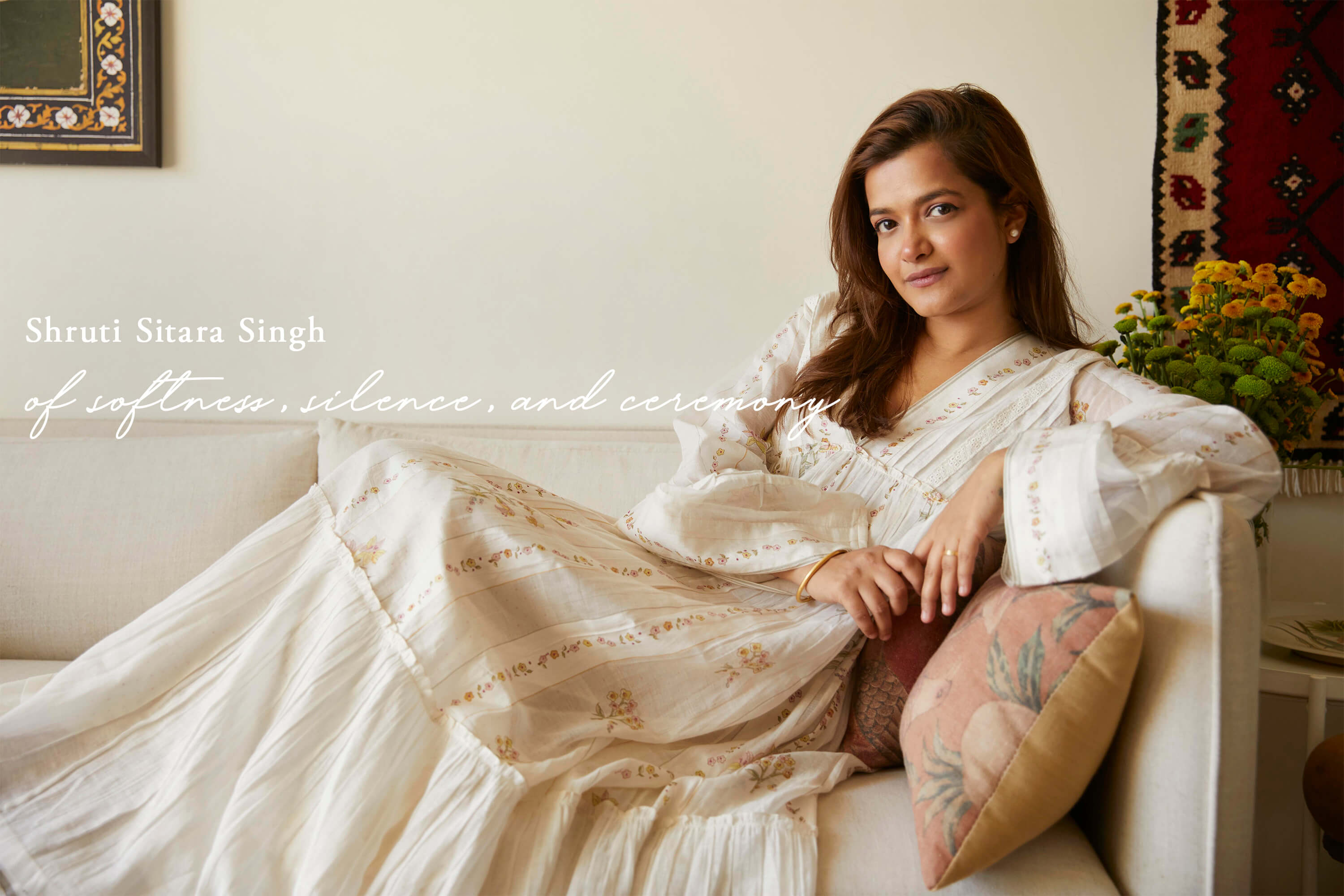Living Between Worlds: Ayesha Erkin on Food, Space & Storytelling
A candid conversation with the architect, cultural curator, and founder exploring how identity, care, and community shape her intentionally nomadic, creative life.
Ayesha Erkin navigates life at the intersection of architecture, food, design, and storytelling. With a multicultural upbringing spanning Turkic and Arab roots, and homes across Pakistan, Saudi Arabia, Germany, and the US, she embodies a hyper-mobile, cosmopolitan life where movement and rootedness coexist. This global rhythm informs how she understands identity and belonging, channelling her experiences into creating spaces—both physical and conceptual—that bridge heritage and connection with care. From founding her studio People, Places & Spaces to co-creating the Global Girls Food Club, Ayesha’s work is a lived narrative of navigating multiple worlds, reflecting on rituals, and celebrating the little things that make life meaningful.
Portrait of a Life in Motion
1. Tell us a bit about yourself and how your creative world came to be.
Ayesha: I’m Ayesha Erkin, an architect by training and the founder of People, Places & Spaces—my culinary, design, and consulting studio. I also co-founded Global Girls Food Club (GGFC), a community that connects women of colour through food, storytelling, and cultural exchange, which has now grown across multiple cities worldwide.
My creative world stems from my multicultural upbringing (Turkic and Arab roots, and living across Pakistan, Saudi Arabia, Germany, and the US), combined with my professional grounding in vernacular and sustainable design. Food, space, and community naturally came together in my work. They became the ways I could connect people, explore identity, and share stories. Even before I realised I was “storytelling,” I was simply living it.
2. What does a month in Ayesha’s life look like? How do you hold both movement and rootedness in your life? Do you see yourself as intentionally nomadic?
Ayesha: A month in my life usually weaves together travel, studio work, community projects, and creative exploration. I try to move my body every day, guided by the principle haraka is baraka—movement is a blessing—which helps me stay grounded even when I’m in flux. Though I’m often navigating multiple cities and cultures, I cultivate rootedness through ritual, anchoring myself in meaningful routines. I wouldn’t call it nomadism for its own sake; it’s more an intentional movement, a way of living that supports both growth and reflection.
3. You move between food, curation, art, and storytelling. Have you always lived at the intersection of these worlds?
Ayesha: Not consciously, at least not at the beginning. Architecture trained me to think spatially and systematically, but over time, food and culture became the mediums through which I explored identity, memory, and connection. Storytelling revealed itself in everyday moments: through the meals I prepared, the spaces I shaped, and the communities I nurtured. It wasn’t something I set out to do deliberately; it unfolded naturally as I navigated the spaces in between.
4. How has your relationship with identity, especially diasporic womanhood, evolved over the years?
Ayesha: It’s been both cyclical and fluid. When I was younger, identity wasn’t something I thought about; it was simply lived experience. It only became a question when I moved somewhere foreign, and others’ curiosity made me reckon with it.
Over time, I’ve cared less about explicit labels. My identity now is rooted in both resilience and rest. I fight, but I also pause and appreciate where I am, honouring the women who made this life possible for me, especially my ancestral lineage. The idea that your grandmother carries you, that a woman’s body holds not only her child but generations before, feels profound and mirrors how I experience womanhood today. Identity continues to shift as we grow, learn, and move, and I’ve come to embrace that fluidity.
5. You speak through the language of care: in food, space, and curation. Where does that instinct come from?
Ayesha: It comes from the Arabic word nafas, the sense of care imbued in something you make for someone else. Care can be tangible, like a dish I cook, or intangible, like the feeling of a space I’ve curated. For me, care is shown through creation: making something with someone in mind, something that quietly says, “I thought of you when I made this.” That instinct is rooted in my upbringing, in hospitality, and in the belief that care is an active, embodied practice.
Where Stories Come to Gather
1. Your idea of a home café and community event designed around gathering, giving, cooking/feeding/eating—tell us how that ritual came to life.
Ayesha: It grew out of a desire to recreate the warmth of home for anyone seeking belonging. Food is the entry point, but the ritual itself is about connection: sharing stories, cooking together, feeding one another, and leaving nourished in both body and spirit. Each event is designed to honour culture, craft, and sustainability. In that way, it reflects my values as well as those of Buna.
2. The streets you walk (bodegas, grocers, train rides) feel like extensions of memory. What do they mean to you now?
Ayesha: They’re key anchors in urban landscapes. Whenever I feel lost, I can pop into one of these spaces, ask questions, and connect. Many of the owners have witnessed these cities shift over decades, and there’s a depth to those interactions. These places are living archives, both sensory and social. They keep me grounded, inform my work, and remind me of the layered histories woven into the city around me.
3. What does a seat at your table look or feel like to someone who’s just arrived?
Ayesha: It’s an invitation to belong, a space where culture, food, and conversation bridge gaps. For someone new, it feels welcoming yet intentional, curated to be nourishing, inclusive, and rich with storytelling, where even silence is honoured.
4. Tell us about how fashion is a tool of expression and/or protest for you.
Ayesha: Fashion is a form of nonverbal storytelling. It’s a way to assert identity, celebrate hybridity, and sometimes challenge expectations. Heritage-inspired pieces, statement accessories, or bold combinations become personal yet political; they allow me to communicate who I am and the narratives I stand for without saying a word.
5. What about Buna speaks to you?
Ayesha: Buna’s commitment to craft, sustainability, and storytelling resonates deeply. It pays homage to heritage while looking forward, and its dedication to creating community spaces aligns with my values—bringing connection and intentionality to every detail of the experience.
6. What are you dreaming about next—in life, or work, or somewhere in between?
Ayesha: I’m trying to turn the “in-between” into something more tangible. I often float between worlds, which has its gifts, but I’ve realised that rootedness allows me to create more meaningfully. I’m building platforms that merge food, design, and cultural storytelling—expanding reach while deepening impact—and creating spaces, whether physical or virtual, where communities can truly connect and thrive.
Ayesha is wearing Plantopia Top and Skirt
A Little Things Rapid Fire
An heirloom you treasure: A ring passed from my grandmother to my mother, and now to me.
A meal you could eat every day: Chicken rice—I had it for the first time in Singapore and became hooked; it’s flavourful, simple, and nourishing.
A (fashion) trend tip you swear by: Invest in statement accessories. I also love reversible pieces for versatility and easy packing.
A city that shaped you: London! Despite not living here full-time, I’ve witnessed myself evolve into many versions of myself over the years in this city.
Comfort food for a hard day: Pumpkin dumplings (kawa manta) with chilli oil and vinegar, an Uyghur favourite I grew up eating.
A ritual that makes you feel grounded: Prayer, five times a day.
Credits
Curation and copy: Gariyashi Bhuyan
Photographs: Zynab Cewalam




Leave a comment
This site is protected by hCaptcha and the hCaptcha Privacy Policy and Terms of Service apply.